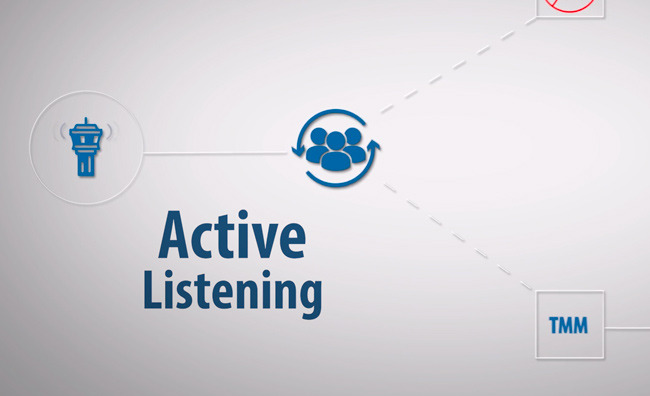Lesson 4: Communications & Conflict Resolution
Introduction
- While air traffic controllers are focused on talking to pilots to control a specific sector of airspace, air traffic managers work with a wide variety of people, including controllers and supervisors, airspace users, and the traffic management personnel at other facilities.
- For that reason, being able to communicate effectively and resolve conflicts quickly are essential skills for traffic management coordinators (TMC).
- These skills are especially important when face-to-face conversations are not possible, and when the people involved work for different, widely dispersed, organizations.
- Adding to the difficulty, communication can be challenging when individuals perceive their underlying interests are different.
- In this lesson, we will discuss communication theories and techniques so you can communicate more effectively with your colleagues and stakeholders.
Lesson Outline
- Communication Skills
- Conflict
- Techniques for Reducing Conflict
- Conflict Resolution
- Advantages of Interest-Based Communications
Lesson Objectives
At the end of this lesson, you will be able to:
- Describe five categories of communication skills in collaborative communications.
- Identify five types of conflict.
- Discuss three language choices for expressing oneself in confrontational situations.
- State five basic methods for resolving conflict.
- State four steps for interest-based communications in the appropriate sequence.
- Recognize the importance of these skills for a TMC.
- Practice effective listening and inquiry communication skills.
Notes:
You will meet the objectives in accordance with the following references:
- “The Mediation Process: Practical Strategies for Resolving Conflict”
(Jossey-Bass, 3rd Edition Revised, 2003), Christopher Moore - “Getting to Yes: Negotiating Agreement Without Giving In”
(Penguin, 3rd edition, 2011), Roger Fisher, William Ury, and Bruce Patton
4.1 Communication Skills
In air traffic management, the most important job function is collaborative communication.
Click below to learn about five communication skills that are important for collaborative communication:
4.2 Conflict
What Is Conflict?
- Conflict is natural and inevitable.
- When conflict is approached with a positive attitude, it can lead to creative resolutions and continuous improvement.
- People can see conflict as unpleasantness to be avoided or as opportunities-in-the-making.
- Negative perceptions of conflict impede people from addressing important issues and finding a constructive resolution.
What Causes Conflict?
Click below to learn about five different types of conflict.
4.3 Techniques for Reducing Conflict
"I" Statements vs. "YOU" Questions
- How you phrase a statement can make a big difference in how the message is received.
- One style of speaking that can spark conflict is called the "I" Statement.
Here’s an example:
- “I think we need to implement a ground stop. I don’t care what XYZ airline thinks.”
- A different style of speaking that can be used to reduce conflict is called the “You Question.”
Here’s an example:
- “Hi, XYZ airline. The storm has reduced airport A’s capacity. So, we’re thinking of implementing a ground stop to mitigate. What is your perspective?”
As you communicate with stakeholders, peers, and management, try to use "You questions" to engage, rather than "I" statements which can cause conflict.
Language Choices for Expressing Yourself
- We always have choices in the way we approach confrontations. The language we use can diffuse a situation or make it worse.
- The following are examples of three sets of oppositional language choices for expressing oneself in potentially confrontational situations.
- Judgmental vs. Descriptive
- Superior vs. Equality
- Discounting vs. Valuing
Judgmental vs. Descriptive
- Judgmental – This language choice arbitrarily positions an idea, action, statement, event, or decision as right or wrong, good or bad, or some other extreme.
- This language may trigger resistance and reaction from others. Then, the focus becomes the rightness of your opinion, rather than on clarifying the comment or event.
- This language may trigger resistance and reaction from others. Then, the focus becomes the rightness of your opinion, rather than on clarifying the comment or event.
- Example: “You are always making assumptions about controllers.”
- Rather than judgmental, a better language choice is descriptive.
- Descriptive – This language choice allows you to express your observations and reactions to an idea, action, statement, event, decision, etc.
- It enables you to seek clarification and input while the other person hears your concerns.
- Example: “It looks like my weather interpretations are not satisfying you. Could you please tell me about what you are looking for?”
Superior vs. Equality Language
- Superior Language - This language choice implies that your ideas and solutions are to be more seriously considered when seeking solutions, and you have the right to control a situation.
- This is commonly exhibited when you use your authority, title, experience, or knowledge to control a situation or force a preferred solution.
- This language will shut down new ideas and reduce participation.
- Example: “If you’d followed the guidelines I developed, you’d have avoided that mistake.”
- Rather than superior, a better language choice is equality.
- Equality Language - This language choice demonstrates that all parties and ideas are equally regarded when seeking solutions.
- By not taking an inflexible position, you allow others to participate in problem solving and become part of the change process.
- Example: “How can we avoid reporting misinformation in the future?”
Discounting vs. Valuing
- Discounting Language – This language choice invalidates the other person’s thoughts or feelings, indicating that they have no value or relevance to the issue at hand.
- Ignoring someone’s feelings does not make them go away.
- It has been said that emotion drives behavior.
- Failure to acknowledge thoughts and feelings and their impact on the issue may result in unsuccessful communications.
- Example: “I don’t care how you feel about…”
- Rather than discounting, a better language choice is valuing.
- Valuing Language – This language choice acknowledges the validity of the other person’s feelings and thoughts (i.e. expresses empathy).
- Empathy and understanding do not necessarily mean agreeing, they mean accepting that the other person has the right to think or feel what they want.
- It allows the other person to vent or express how they feel.
- And it allows others to move beyond their own frustrations or positions to work through alternatives and seek solutions.
- Example: “I’m uncomfortable suggesting a ground delay program now. How do you see it?”
- Being able to use descriptive, equality, and valuing language without thinking about it may take practice, but it’s worth it.
- The more you practice, the more confident you will feel using these language choices.
- As you gain this experience, your skills in conflict resolution will get better as well.
4.4 Conflict Resolution
- How do people resolve conflict?
- One theory states that conflict resolution happens when people understand each other's position accurately. They are willing to discuss it, because they want to resolve the conflict, regardless of their disagreements. Resolution occurs only when everyone tries to reach mutually satisfying solutions.
- Just like language choices, people use a variety of methods to deal with conflict. Some methods achieve agreement, but not a win-win situation for everyone.
- Researchers summarized these techniques in the “Five Basic Methods of Conflict Resolution.”
- Below, we describe the methods and when they may or may not be appropriate.
- Being aware of these techniques may help you make appropriate choices when resolving conflict.
Five Methods of Conflict Resolution
Avoidance or denial
- A person using this method is usually trying to get rid of the conflict by denying it exists or refusing to acknowledge it.
- Instead of disappearing, the conflict grows and becomes unmanageable.
- Result is a lose/lose situation.
- Inappropriate to use when:
- The issue is important and will not disappear, but build.
- When people are powerless to express themselves and their concerns.
- May be appropriate to use when:
- It is a short-term issue that is relatively unimportant.
- The timing is wrong or a cooling-off period is needed.
Accommodation
- A person using this method usually plays down differences, not recognizing the benefits of handling conflict openly.
- One person "gives in," but the source of the conflict rarely goes away.
- Result is a win/lose situation.
- Surface harmony may exist, but resentment, defensiveness, and possible sabotage may occur if the issue is suppressed.
- Inappropriate to use when:
- Reluctance to deal with the conflict leads to evasion of an important issue.
- Others are ready and willing to deal with the issue.
- May be appropriate to use when:
- It is more important to preserve a relationship than to deal with an insignificant issue through conflict.
Competition
- A person using this method may act in an assertive way to achieve their goals without trying to cooperate, possibly at the expense of others. Competition as a method for resolving conflict can create power struggles.
- Power is often used to settle differences.
- Power can come from a person’s authority or position, majority rule, or a persuasive minority.
- When power is used to settle a conflict, it may mean the best solutions are not discussed and not everyone is heard.
- Power strategies result in winners and losers, and the loser will not usually support the final decision in the same way winners will.
- Future meetings of the group may then be tainted by the conscious or unconscious renewal of the struggle previously “settled” by the use of power.
- In some instances, where other forms of handling conflict are clearly inappropriate, use of power can be effective.
- Inappropriate to use when:
- Losers have no way to express needs; could result in future disruptions.
- May be appropriate to use when:
- Power comes with position of authority.
- This method has been agreed upon.
- Ethical or safety concerns are important.
- There is an emergency, time is of the essence, or where you need quick, decisive action.
Compromise or negotiation
- People using this method usually end up giving something up to reach an agreement.
- Negotiation can be defined as a transaction in which everyone has a veto on the final outcome.
- In other words, in a negotiation, everyone has to consent to the outcome for it to be implemented and everyone has an interest in the others agreeing to it.
- Thus, by negotiating, we make a joint decision.
- This method is viewed as honorable, but it has some disadvantages.
- Bargaining often causes all sides to assume an inflated position, since each is aware that the other is going to “give a little.”
- The compromise solution may be watered down or weakened to the point where it will not be effective, and there is often not enough commitment by everyone.
- It will result in a win/lose situation if “meeting in the middle” ignores the real diversity of the issue.
- Inappropriate to use when:
- The inflated position is unrealistic.
- The solution is too watered down to be effective.
- Everyone involved doubts the others’ commitment.
- May be appropriate to use when:
- Everyone has enough leeway to give.
- Resources or time are limited.
Collaboration or integration
- When using this approach, everyone recognizes the abilities and expertise of the others.
- Each individual’s position is clear and well prepared, but the emphasis of the group is to solve the problem at hand, rather than defend particular positions or factions.
- All involved expect to modify their original view as the group’s work progresses.
- Ultimately, the best of the group’s thinking will emerge.
- Everyone believes the group effort exceeds the sum of the individual member contributions.
- If time, abilities, and commitment are present, this is usually the best conflict resolution technique.
- Result is a win/win situation for all.
- Inappropriate to use when:
- The conditions of time, abilities, and commitment are not present.
- May be appropriate to use when:
- Time is available to complete the process; everyone is committed and trained in use of process.
- Using a collaborative approach and working toward a situation where everyone wins can be very rewarding, especially in a setting where achieving a system-wide, rather than individual, goal is important.
- NOTE: Occasionally, there is some confusion between compromise and collaboration.
- In compromise, there is a quick solution in which everyone agrees to accept a middle-ground solution.
- In collaboration, people work hard to find a solution that allows everyone to get all—or most—of what they need.
Ten hints for conflict resolution:
- Nurture a positive atmosphere.
- Clarify perceptions of yourself and your position.
- Clarify perceptions of the other parties.
- Clarify perceptions of the causes of the conflict.
- Clarify the underlying factors of the cause.
- Be in charge of your responses.
- Encourage parties to express feelings.
- Focus on shared needs and goals.
- Generate options.
- Develop and implement 'do-able' parts.
Five Basic Methods For Resolving Conflict
By learning and practicing the art of collaboration, TMCs can foster win/win situations.
To review the above methods of conflict resolution, download this PDF:
The Five Basic Methods For Resolving Conflict
In this lesson, you learned:
- Different communications skills encourage collaboration, such as listening with your full attention, asking questions, keeping the conversation focused, and respecting others’ values.
- Conflict may seem unpleasant, however, addressing it constructively can lead to mutually beneficial solutions.
- The language you use in a confrontation makes a difference; word choices can trigger resistance and reduce participation or they can encourage input, show people they are valued, and help everyone move beyond frustrations.
- Some methods of conflict resolution may work short-term, but only collaboration helps people work together to solve the problem, rather than defend a particular position.
- Interest-based communications reframes conflicts as interests; people reach agreement after brainstorming options.
Lesson 4 Knowledge Checks
 Lesson 4 Knowledge CheckMultiple Choice
Lesson 4 Knowledge CheckMultiple Choice Lesson 4 Knowledge CheckMatching Quiz
Lesson 4 Knowledge CheckMatching Quiz

